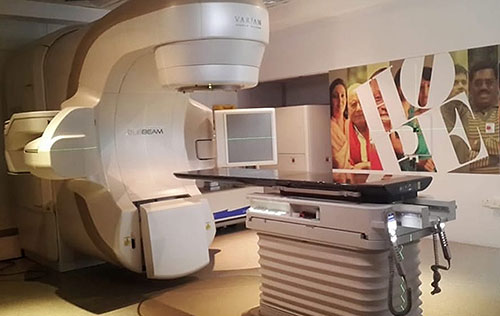What is Radiotherapy? – What You Need to Know
When a person comes across the word “radiotherapy”, it reminds him/her about the electric current. Some people may call the treatment “shock treatment” which is absolutely a myth. Radiotherapy is a form of cancer treatment using x-rays or gamma rays. The treatment is delivered by using a machine called “linear accelerator”. The treatment is given five days a week, usually for a period of 4-6 weeks. It is a painless procedure and the side effects are minimal with the use of higher-end techniques like IMRT, IGRT, Rapid Arc and SBRT.

Our radiotherapy department consists of a team of well trained oncologists, physicists, technologists, nurses and supporting staff. Radiotherapy can be given before surgery (neo-adjuvant), after surgery (adjuvant) or can be given with chemotherapy (concurrent chemo radiotherapy) to avoid surgery. In some patients, it can be given to alleviate the symptoms of cancer like pain, bleeding, etc., where it is called as palliative radiation. Some non-cancerous conditions can also be treated with radiotherapy. Radiotherapy treatment can be given for a majority of the cancers from the head to the foot.
With the advancements in technology, the treatment is so precise that it targets only the tumor cells, causing very minimal damage to normal tissues. In the modern era, radiation along with chemotherapy can help patients in avoiding surgery thereby helping in organ (function) preservation which in turn helps the patients to have good cosmesis and better quality of life. This is especially seen in throat cancer where the surgery will entail removal of the windpipe and loss of voice whereas radiotherapy can cure the disease without the need for removal of the windpipe. In early breast cancer patients, if the tumor alone is removed (lumpectomy), radiation can prevent the disease from coming back in primary tumor site thereby giving good cosmetic outcome and the treatment can be completed within a week (fast-forward protocol). In gynecological malignancies, especially cancer cervix, it alleviates the need for morbid surgery. In early throat cancer patients, radiation alone can cure the disease avoiding the need for chemotherapy as well as surgery with very minimal side-effects. The dryness of the mouth (xerostomia), a common side effect of radiotherapy in head & neck cancers, can be minimized by using “parotid salivary gland sparing” technique. The dose to the heart and its vessels (coronary arteries), especially in left-sided breast cancer patients, can be reduced by using “breath hold” technique and “cardiac sparing” technique. The cancer in the lung and the liver can be accurately targeted and treated by using “gating” technique. In pelvic malignancies, the dose to the bladder and the bowel can be minimized using protocol-based radiotherapy. In early prostate cancer patients, the total treatment time can be reduced to 1-2 weeks using “SBRT technique” as against 6-7 weeks of treatment using “conventional technique”. In patients with cancer which has spread to the brain, use the of “SRS & SRT” techniques (hippocampal sparing) can reduce the duration of treatment from 12 days to 5 days maximum with preservation of memory and other higher mental functions.
Kindly remember that cancer is curable, if detected early.

Dr. A. N. Aswin
Consultant Radiation Oncologist & Palliative Care
Kauvery Hospital Chennai
